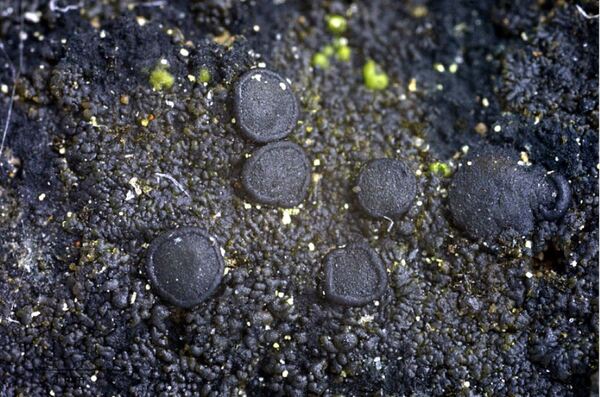Placynthium tremniacum (A. Massal.) Jatta
Syll. Lich. Ital.: 38, 1900. Basionym: Racoblenna tremniaca A. Massal. - Ric. Auton. Lich. Crost.: 140, 1852.
Synonyms:
Distribution: N - Ven (Lazzarin 2000b), Lig (S- F155907).
Description: Thallus crustose to subsquamulose, shining brown to almost black, epruinose or weakly pruinose, cracked-areolate and granulose-isidioid in central parts, forming up to 3 cm wide patches, the marginal parts indistinctly lobulate, the lobules up to 0.25 mm long, 62-75 µm wide; prothallus very poorly developed. Apothecia rare, to 1 mm across, semi-immersed to sessile, with a dark brown disc and a thin, often finally excluded proper margin. Epithecium dark violaceous or dark greenish; hymenium colourless, amyloid; paraphyses distinctly septate, sparingly branched; subhymenium brownish. Asci 8-spored, apically thickened, with an amyloid cap. Ascospores mainly 1-septate, hyaline, ellipsoid, (9-)10-15(-17) x 4-6(-7) µm. Pycnidia rare, dark-coloured, immersed, laminal, to 0.1 mm wide, the wall greenish black at least in upper part. Conidia 1-celled, hyaline, bacilliform, 3-4 x c. 1 µm. Photobiont cyanobacterial, Scytonema-like. Spot tests: all negative. Chemistry: without lichen substances.Note: the 1-septate spores, the thallus with somewhat stouter, more or less flat, minute squamules, and the less developed prothallus distinguish this rather poorly known species from P. nigrum. Czeika & Czeika (2007), however, consider this species as a synonym of the latter.
Growth form: Crustose
Substrata: rocks
Photobiont: cyanobacteria, filamentous (e.g. Nostoc, Scytonema)
Reproductive strategy: mainly sexual
Commonnes-rarity: (info)
Alpine belt: very rare
Subalpine belt: very rare
Oromediterranean belt: very rare
Montane belt: very rare
Submediterranean belt: very rare
Padanian area: very rare
Humid submediterranean belt: very rare
Humid mediterranean belt: very rare
Dry mediterranean belt: very rare

Predictive model
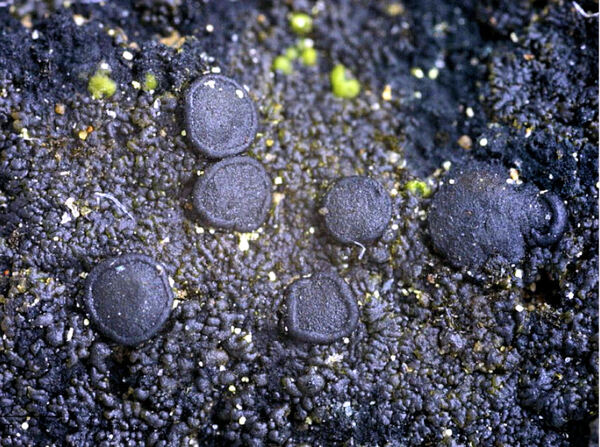

Felix Schumm CC BY-SA 4.0
[12304], Griechenland, N-Samos, an der Straße von Agios Konstandinos nach Manolates, 37°47.229'N, 26°49.387'E, 205 m; feuchte, schattige Felswand in Bachnähe.
Leg. Schumm 02.05.2006, det. Schumm 2006.
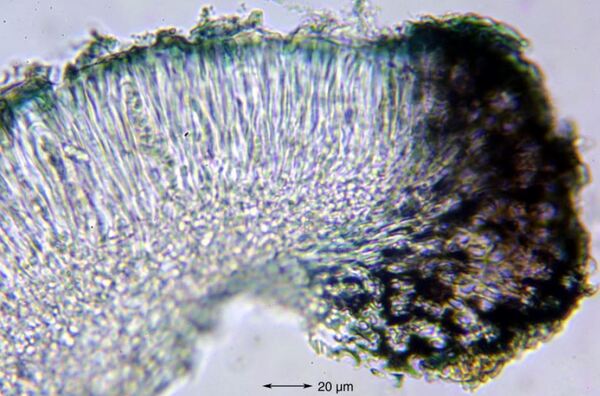

Felix Schumm – CC BY-SA 4.0
[12304], Griechenland, N-Samos, an der Straße von Agios Konstandinos nach Manolates, 37°47.229'N, 26°49.387'E, 205 m; feuchte, schattige Felswand in Bachnähe. Leg. Schumm 02.05.2006, det. Schumm 2006.
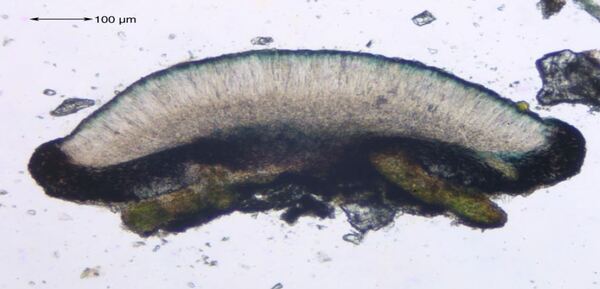

Felix Schumm – CC BY-SA 4.0
[12304], Griechenland, N-Samos, an der Straße von Agios Konstandinos nach Manolates, 37°47.229'N, 26°49.387'E, 205 m; feuchte, schattige Felswand in Bachnähe. Leg. Schumm 02.05.2006, det. Schumm 2006.
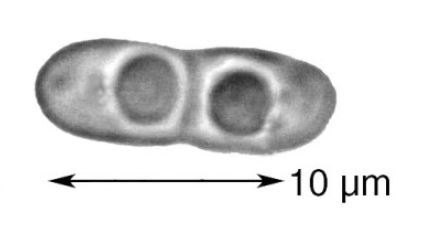

Felix Schumm – CC BY-SA 4.0
[12304], Griechenland, N-Samos, an der Straße von Agios Konstandinos nach Manolates, 37°47.229'N, 26°49.387'E, 205 m; feuchte, schattige Felswand in Bachnähe. Leg. Schumm 02.05.2006, det. Schumm 2006.
Growth form: Crustose
Substrata: rocks
Photobiont: cyanobacteria, filamentous (e.g. Nostoc, Scytonema)
Reproductive strategy: mainly sexual
Commonnes-rarity: (info)
Alpine belt: very rare
Subalpine belt: very rare
Oromediterranean belt: very rare
Montane belt: very rare
Submediterranean belt: very rare
Padanian area: very rare
Humid submediterranean belt: very rare
Humid mediterranean belt: very rare
Dry mediterranean belt: very rare

Predictive model


Felix Schumm CC BY-SA 4.0
[12304], Griechenland, N-Samos, an der Straße von Agios Konstandinos nach Manolates, 37°47.229'N, 26°49.387'E, 205 m; feuchte, schattige Felswand in Bachnähe.
Leg. Schumm 02.05.2006, det. Schumm 2006.


Felix Schumm – CC BY-SA 4.0
[12304], Griechenland, N-Samos, an der Straße von Agios Konstandinos nach Manolates, 37°47.229'N, 26°49.387'E, 205 m; feuchte, schattige Felswand in Bachnähe. Leg. Schumm 02.05.2006, det. Schumm 2006.


Felix Schumm – CC BY-SA 4.0
[12304], Griechenland, N-Samos, an der Straße von Agios Konstandinos nach Manolates, 37°47.229'N, 26°49.387'E, 205 m; feuchte, schattige Felswand in Bachnähe. Leg. Schumm 02.05.2006, det. Schumm 2006.


 INDEX FUNGORUM
INDEX FUNGORUM
 GBIF
GBIF
 DOLICHENS
DOLICHENS

